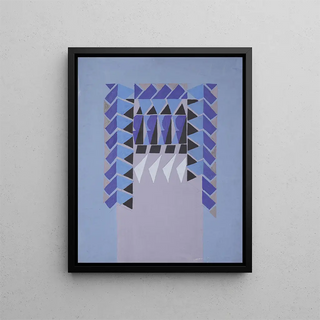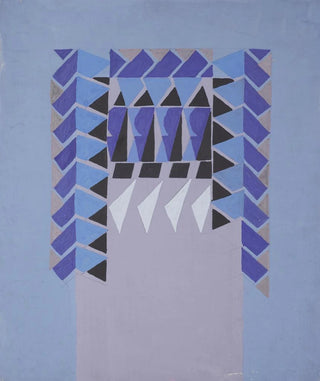Untitled Textile Drawing No. I - Frances Hodgkins | Art print


View from behind

Frame (optional)
In the world of art, some works manage to transcend their era, capturing the essence of a sensibility and evoking deep emotions. "Untitled Textile Drawing No. I - Frances Hodgkins" is a perfect example. This piece, which belongs to the modernist movement, immerses us in a universe where color and form intertwine with rare harmony. The textile drawing, far from being a simple study, reveals itself as a true ode to creativity, an exploration of textures and patterns that invite us to reflect on the relationship between art and craftsmanship. Through this art print, the viewer is invited on a sensory journey, where each pencil stroke resonates like a note in a visual symphony.
Style and uniqueness of the work
Frances Hodgkins' style is distinguished by her bold approach and innovative use of colors. In "Untitled Textile Drawing No. I," the artist deploys a vibrant palette that evokes light and life, while playing with contrasts and nuances. The fluid and organic lines, combined with geometric patterns, create a captivating dynamic that draws the eye. This art print is also characterized by a certain lightness, a sense of movement that seems to emanate from the page. Hodgkins succeeds in capturing the very essence of the materials she depicts, transforming the simple drawing into a reflection on the very nature of textile art. Thus, this work becomes a testament to the richness of artisanal traditions, while asserting a modernity.
The artist and her influence
Frances Hodgkins, an emblematic figure of modern art, knew how to mark her era with her boldness and creativity. Born in New Zealand, she was influenced by the landscapes of her homeland, but also by her travels in Europe, notably in England and France. These experiences nourished her art, allowing her to incorporate elements of post-impressionism and fauvism into her creations. Hodgkins was also a pioneer in exploring mixed techniques, combining drawing, painting, and textile art. Her influence extends beyond

Matte finish

View from behind

Frame (optional)
In the world of art, some works manage to transcend their era, capturing the essence of a sensibility and evoking deep emotions. "Untitled Textile Drawing No. I - Frances Hodgkins" is a perfect example. This piece, which belongs to the modernist movement, immerses us in a universe where color and form intertwine with rare harmony. The textile drawing, far from being a simple study, reveals itself as a true ode to creativity, an exploration of textures and patterns that invite us to reflect on the relationship between art and craftsmanship. Through this art print, the viewer is invited on a sensory journey, where each pencil stroke resonates like a note in a visual symphony.
Style and uniqueness of the work
Frances Hodgkins' style is distinguished by her bold approach and innovative use of colors. In "Untitled Textile Drawing No. I," the artist deploys a vibrant palette that evokes light and life, while playing with contrasts and nuances. The fluid and organic lines, combined with geometric patterns, create a captivating dynamic that draws the eye. This art print is also characterized by a certain lightness, a sense of movement that seems to emanate from the page. Hodgkins succeeds in capturing the very essence of the materials she depicts, transforming the simple drawing into a reflection on the very nature of textile art. Thus, this work becomes a testament to the richness of artisanal traditions, while asserting a modernity.
The artist and her influence
Frances Hodgkins, an emblematic figure of modern art, knew how to mark her era with her boldness and creativity. Born in New Zealand, she was influenced by the landscapes of her homeland, but also by her travels in Europe, notably in England and France. These experiences nourished her art, allowing her to incorporate elements of post-impressionism and fauvism into her creations. Hodgkins was also a pioneer in exploring mixed techniques, combining drawing, painting, and textile art. Her influence extends beyond
12,34 €






